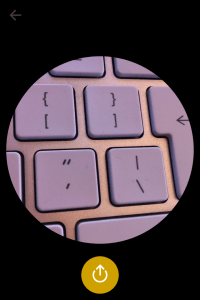U.K. mobile games and app developer studio ustwo, creator of games and apps like Whale Trail and MouthOff to name a couple, has launched a new photo-sharing app called Rando. The kicker is it’s entirely random photo sharing. In other words, each of your photos (‘randos’) is randomly sent to another user (you never know who gets it). In return you receive a random rando — also from a random user, with only a general location such as ‘Moscow’ for context. So totally random then.
All Rando photos are framed within circles — to give a peep-hole effect, says ustwo, as well as to create a distinctive design element to distinguish the “rando brand”.
Unlike most photo-sharing apps, Rando eschews the usual social network trappings. You can’t like photos, favourite them, comment on them or share them to other social networks directly from the app. But this is very much a feature, not a bug: ustwo calls Rando an “anti-social photosharing app”. (There are still a fair few bugs in the app though — but ustwo says a new more stable build should go live on the AppStore tomorrow.)
 This means that Rando feels closer in philosophy to ephemeral photo-messaging app Snapchat, which deliberates curtails social exposure by auto-destructing photos after they have been viewed, than it does to a highly visible, highly self-conscious image swapping network like Instagram.
This means that Rando feels closer in philosophy to ephemeral photo-messaging app Snapchat, which deliberates curtails social exposure by auto-destructing photos after they have been viewed, than it does to a highly visible, highly self-conscious image swapping network like Instagram.
Setting aside sending and viewing randos (and waiting to receive them), all you can currently do is delete received randos so they don’t live forever in your stack, or flag a rando as inappropriate — always a risk with apps that let strangers swap visual messages. Still, the risk of Rando being deluged with porn, a la Chatroulette or the early days of Vine, seems fairly low. For starters, this is static photo-sharing (not video) so the hardcore exhibitionists will probably look elsewhere to get their kicks.
There’s also no instantaneous photo swap gratification: after you’ve sent a rando you have to wait in a queue til a rando has been created that can be sent to you. So at quieter times you could be waiting hours. Which doesn’t sound like the ideal environs for flashers to flourish. The app doesn’t support pure voyeurists either since you can’t just view other people’s randos. You have to make and send a rando to get one back.
That said, random photo-sharing does offer almost no social checks and balances (apart from, presumably, having your account suspended if your randos get flagged as filth) so the kind of content that can be shared is obviously less straitjacked by who you are and who your friends are than most photo sharing apps. And that is a big is part of ustwo’s rational for making the app. Specifically it says it wanted to find out what would happen
…when you cannot communicate between users in this social-media world that we’re living in today? Are users still going to be incentivised if they have no way of patting each other on the back with likes? Are you going to be engaged if you can’t follow specific users? And what happens when you are producing something but have no control over who will see it?
All interesting questions to ask in the context of social photo-sharing, which arguably limits what can be photographed — whether it’s for vanity/self-consciousness, broader feelings of propriety, or general pressure to conform or gain tacit approval from a peer group. No one wants their socially shared photo to be the one that’s overlooked or singled out negatively — or why bother sharing it in the first place?
Rando therefore offers a channel to share quotidian, boring, ugly or otherwise awkward shots, but whether there’s a huge appetite for that remains to be seen. It’s notable that ustwo will be adding filters to the app — with “fresh feel” and “vintage/film like” filters planned for starters — so it’s not abandoning the pretentious side of photo-swappery entirely.
Does the world really need another photo-sharing app? ustwo co-founder Matt Miller (aka Mills) says absolutely it does — if it’s doing something “liberating”, ie, not following the usual social sharing cookie-cutter template.
“Rando is designed to connect people/users to the world without the burden of befriending/ following other users. That in itself offers freedom for users on a number of levels. No comments, likes, sharing, re-sharing, friends, titles, captions, hashtags – it’s just you and the pictures,” he tells TechCrunch. “By removing the need to follow users we’ve increased the chance of receiving a variety of photos from unexpected places throughout the world. For example – personally using instagram with my circle of contacts it’s unlikely I’d ever receive a photo from the deepest part of Russia or the Dominican Republic. Rando delivers unexpected results in a very liberating way with no one else receiving the same photo as you.”
“We hope users will share pictures from their every day lives, like a sneak peek into their own reality. We want the emphasis of taking a photograph to be less deliberate in the sense that users aren’t driven to share a picture purely because of how many likes/ comments it will receive. Therefore it’s more about giving than bragging, and hopefully it will get some users reflecting on the drivers behind why they use social media more generally,” he adds.
Panning out to look at the wider digital landscape, there’s no sign of photo-sharing fatigue. Quite the opposite. Image sharing dominates social networks like Facebook, which recently tweaked its News Feed to make images larger, among other changes (not to mention shelling out $1 billion to pocket photo-sharing social network Instagram last year). Facebook’s Instagram buy led Twitter to add its own photo filters to its apps. And also last year: Google bought image-editing app Snapseed. Among its changes to the app are sharing options that now feature its own social network Google+ in a prominent position.
With cameraphones ubiquitous in developed markets, photos remain the social currency du jour and everyone but everyone is swapping them. So the emergence of new apps trying to find novel and interesting ways to share pictures simply underlines the continued rude health of visual communication, however many photo sharing apps are already out there. As my colleague Alexia put it back in December, photosharing is beloved because “humans are very, very visual creatures and have been for about 200k years”.
Rando is by no means the only app newcomer focusing in on photo sharing. A couple of others that have recently crossed our path include Povio (below) — which bills itself as a “mobile communication app that uses photos to communicate and engage, because photos are the easiest to create and consume”. Povio users a Facebook sign in and then lets users share and view photos with followed friends, creating a photo-only News Feed for the mobile phone, and letting users ‘ping’ photos back and forth to each other. 
There’s also photo-focused social network We Heart Pics, which launched last year and has amassed 150,000 users (but claims it only started marketing recently), aiming to rebuild the social network with photography at the centre, rather than text — to prove its thesis that “pictures are the future of social communication”.
So, while Rando is undoubtedly a bit random — and certainly also part experiment (ustwo’s Mills talks about how it wanted to “launch a project as quickly as possible”), and part marketing exercise to sell the abilities of ustwo the ‘user interface and user experience design studio’ (the company has made apps for the likes of Barclays and McDonalds). It is also more than just a curiosity: it’s yet more evidence that pictures are beating words in our time-pressed, tap-happy, visually hungry times.
Whether random photo-sharing could ever support a business model in and of itself hardly seems to matter — so long as they’re grabbing and entertaining enough eyeballs.
“Since we launched late last week we’ve had 16k downloads with over 130k Randos sent and received,” says Mills. “Our main mission now is to get Rando in the hands of as many users as possible.”
